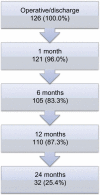A multicenter prospective study of patients undergoing open ventral hernia repair with intraperitoneal positioning using the monofilament polyester composite ventral patch: interim results of the PANACEA study
- PMID: 28553149
- PMCID: PMC5440003
- DOI: 10.2147/MDER.S132755
A multicenter prospective study of patients undergoing open ventral hernia repair with intraperitoneal positioning using the monofilament polyester composite ventral patch: interim results of the PANACEA study
Abstract
Purpose: This study assessed the recurrence rate and other safety and efficacy parameters following ventral hernia repair with a polyester composite prosthesis (Parietex™ Composite Ventral Patch [PCO-VP]).
Patients and methods: A single-arm, multicenter prospective study of 126 patients undergoing open ventral hernia repair with the PCO-VP was performed. Patient outcomes were assessed at discharge and at 10 days, 1, 6, 12, and 24 months postoperative.
Results: All patients had hernioplasty for umbilical (n = 110, 87.3%) or epigastric hernia (n = 16, 12.7%). Mean hernia diameter was 1.8 ± 0.8 cm. Mean operative time was 36.2 ±15.6 minutes, with a mean mesh positioning time of 8.1 ± 3.4 minutes. Surgeons reported satisfaction with mesh ease of use in 95% of surgeries. The cumulative hernia recurrence rate at 1 year was 2.8% (3/106). Numeric Rating Scale (NRS) pain scores showed improvement from 2.1 ± 2.0 at preoperative baseline to 0.5 ± 0.7 at 1 month postoperative (P < 0.001), and this low pain level was maintained at 12 months postsurgery (P < 0.001). The mean global Carolina's Comfort Scale® (CCS) score improved postoperatively from 3.8 ± 6.2 at 1 month to 1.6 ± 3.5 at 6 months (P < 0.001). One patient was unsatisfied with the procedure.
Conclusion: This 1-year interim analysis using PCO-VP for primary umbilical and epigastric defects shows promising results in terms of mesh ease of use, postoperative pain, and patient satisfaction. Recurrence rate is low, but, as laparoscopic evaluation shows a need for patch repositioning in some cases, an accurate surgical technique remains of utmost importance.
Keywords: epigastric hernia; intraperitoneal mesh; pain; umbilical hernia.
Conflict of interest statement
Disclosure The authors report no conflicts of interest in this work.
Figures



References
-
- Christoffersen MW, Helgstrand F, Rosenberg J, Kehlet H, Strandfelt P, Bisgaard T. Long-term recurrence and chronic pain after repair for small umbilical or epigastric hernias: a regional cohort study. Am J Surg. 2015;209(4):725–732. - PubMed
-
- Arroyo A, Garcia P, Perez F, Andreu J, Candela F, Calpena R. Random-ized clinical trial comparing suture and mesh repair of umbilical hernia in adults. Br J Surg. 2001;88(10):1321–1323. - PubMed
-
- Aslani N, Brown CJ. Does mesh offer an advantage over tissue in the open repair of umbilical hernias? A systematic review and meta-analysis. Hernia. 2010;14(5):455–462. - PubMed
-
- Sanjay P, Reid TD, Davies EL, Arumugam PJ, Woodward A. Retrospective comparison of mesh and sutured repair for adult umbilical hernias. Hernia. 2005;9(3):248–251. - PubMed
-
- Berrevoet F, Van den Bossche B, de Baerdemaeker L, de Hemptinne B. Laparoscopic evaluation shows deficiencies in memory ring deployment during small ventral hernia repair. World J Surg. 2010;34(7):1710–1715. - PubMed
LinkOut - more resources
Full Text Sources
Other Literature Sources

